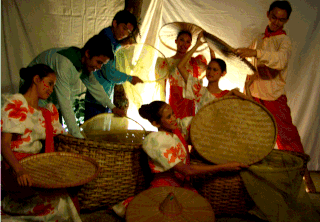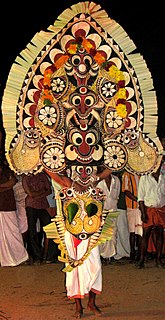
Flamenco, in its strictest sense, is a professionalized art-form based on the various folkloric music traditions of southern Spain in the autonomous communities of Andalusia, Extremadura and Murcia. In a wider sense, it refers to these musical traditions and more modern musical styles which have themselves been deeply influenced by and become blurred with the development of flamenco over the past two centuries. It includes cante (singing), toque, baile (dance), jaleo, palmas (handclapping) and pitos.

Zambales is a province in the Philippines located in the Central Luzon region in the island of Luzon. Its capital is the Municipality of Iba which is strategically located in the middle of the province. Zambales borders Pangasinan to the north and northeast, Tarlac to the east, Pampanga to the southeast, Bataan to the south and the West Philippine Sea to the west. With a total land area of 3,830.83 square kilometres (1,479.09 sq mi), Zambales is the second largest among the seven provinces of Central Luzon after Nueva Ecija. The province is noted for its mangoes, which are abundant from January to April.

Music of the Philippines include musical performance arts in the Philippines or by Filipinos composed in various genres and styles. The compositions are often a mixture of different Asian, Spanish, Latin American, American, and indigenous influences.
The folklore of India compasses the folklore of the nation of India and the Indian subcontinent. India is an ethnically and religiously diverse country. Given this diversity, it is difficult to generalize widely about the folklore of India as a unit.

The culture of Kerala is a synthesis of Aryan and Dravidian cultures, developed and mixed for centuries, under influences from other parts of India and abroad. It is defined by its antiquity and the organic continuity sustained by the Malayali people. Modern Kerala society took shape owing to migrations from different parts of India and abroad throughout Classical Antiquity.

Tinikling is a traditional Philippine folk dance which originated during the Spanish colonial era. The dance involves two people beating, tapping, and sliding bamboo poles on the ground and against each other in coordination with one or more dancers who step over and in between the poles in a dance. It is traditionally danced to rondalla music, a sort of serenade played by an ensemble of stringed instruments which originated in Spain during the Middle Ages.
Ballet Philippines (BP) is a ballet company in the Philippines founded in 1969 by Alice Reyes with the support of Eddie Elejar and the Cultural Center of the Philippines. Proficient in both ballet and modern dance, the company synthesizes diverse dance and movement forms, from classical ballet to avant-garde choreography, from traditional dance to modern dance, from martial arts to aerial movements, into distinctively Filipino contemporary expressions.

The Alvin Ailey American Dance Theater (AAADT) is a modern dance company based in New York, New York. It was founded in 1958 by choreographer and dancer Alvin Ailey. It is made up of 32 dancers, led by artistic director Robert Battle and associate artistic director Masazumi Chaya.

Singkíl is a folk dance of the Maranao people of Lake Lanao based on the epic legend Darangen. which was popularised by the Bayanihan Philippine National Folk Dance Company.
Pol-Art is a Polish cultural event held in the State capital cities around Australia. The last event took place between 28 December 2015 and 5 January 2016 and was held in Melbourne, Victoria. Brisbane hosts the next Pol-Art from 27 December 2018 to 06 January 2019.

The International Ballet Festival of Havana(Festival de Ballet de La Habana), is a ballet festival held in the Great Theater of Havana, Cuba and other locations like Karl Marx Theatre and Mella Theatre every two years. Created in 1960 by a joint effort of the Ballet Nacional de Cuba, the Instituto Nacional de la Industria Turística and the cultural organizations of the government, the International Ballet Festival of Havana was added to the plans of massive diffusion of arts started after the popular Cuban Revolution on January 1, 1959.
The Bayanihan Philippine National Folk Dance Company is the oldest dance company in the Philippines. A multi-awarded company, both nationally and internationally, Guillermo Gomez Rivera has called it the "depository of almost all Filipino dances, dress and songs."

Philippine dance has played a tremendous role in Philippine culture. From one of the oldest dated dances called the Tinikling, which originated from the Spanish Colonial Era, to other folkloric dances such as the Pandanggo, Cariñosa, and Subli, and even to more modern-day dances like the Ballet, it is no doubt that dance in the Philippine setting has integrated itself in society over the course of many years and is significantly imbedded in our culture. Each of these dances originated in a unique way and serve a certain purpose, showcasing how diverse Philippine dances are.
Raúl de Ramón, full name Raúl Alberto de Ramón García del Postigo, was a Chilean composer, musician and folklorist and author of numerous widely known songs in Chile, such as The Curanto, Nostalgia Colchaguina, Camino de Soledad, Rosa Colorada, Canción de la Caballería, El Amor del Arriero and many more.

Ballet Manila is a classical ballet institution and dance company in the Philippines. It currently highlights more than fifty highly trained dancers in the highly rigorous Russian (Vaganova) method of classical ballet. Locally the company has performed in 47 cities holding more than 4,100 performances. The company has done tours in Asia, Europe and North America, where it has held more than 140 performances. The company is most notable for its in-house creative director, principal dancer and prima ballerina Lisa Macuja-Elizalde. Along with Ballet Philippines and the Philippine Ballet Theatre, Ballet Manila is one of the three major ballet companies in the Philippines. It regularly holds its performances at the Aliw theater and Star Theater, which are both located within Star City at Pasay City. The concept of a ballet company by the dancers, of the dancers and for the dancers was the idea of Lisa Macuja-Elizalde when she, along with ballet master Osias Barroso and ten other dancers established Ballet Manila in 1995.

Villa Escudero Plantations is 800 hectares of working coconut plantation and hacienda located 10 kilometres (6.2 mi) south of the city of San Pablo, Laguna Province on the border with Quezon Province in the Philippines. Since 1981, the plantation has opened its doors as a resort offering village tours, museum tour, food and accommodations. It has developed a worldwide reputation as a focal point to experience Philippine culture and history in a beautiful rural setting.

Padayani, also called Padeni, is a traditional folk dance and a ritual art from the central portion of the Indian state of Kerala. A ceremonial dance involving masks, it is an ancient ritual performed in Bhagavati temples. The dance is performed in honor of Bhadrakaali. Meaning, a 'row of warriors', Padayani is an art form that blends music, dance, theatre, satire, facial masks, and paintings. It is part of worship of Bhadrakali and is staged in temples dedicated to the goddess from mid-December to mid-May. Padayani is unique to central Travancore, comprising the Pathanamthitta district of Kerala. Padayani is regarded as a remnant of the Dravidian forms of worship that existed before the advent of Brahmanism.












